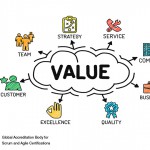A project is a collaborative enterprise to either create new products or services or to deliver results as defined in the Project Vision Statement. Projects are usually impacted by constraints of time, cost, scope, quality, people, and organizational capabilities. Usually, the results generated by projects are expected to create some form of business or service value.
Since value is a primary reason for any organization to move forward with a project, Value-driven Delivery must be the main focus. Delivering value is ingrained in the Scrum framework. Scrum facilitates delivery of value very early on in the project and continues to do so throughout the project lifecycle.
One of the key characteristics of any project is the uncertainty of results or outcomes. It is impossible to guarantee project success at completion, irrespective of the size or complexity of a project. Considering this uncertainty of achieving success, it is therefore important to start delivering results as early in the project as possible. This early delivery of results, and thereby value, provides an opportunity for reinvestment and proves the worth of the project to interested stakeholders.
In order to provide Value-driven Delivery, it is important to:
- Understand what adds value to customers and users and to prioritize the high value requirements on the top of the Prioritized Product Backlog.
- Decrease uncertainty and constantly address risks that can potentially decrease value if they materialize. Also work closely with project stakeholders showing them product increments at the end of each Sprint, enabling effective management of changes.
- Create Deliverables based on the priorities determined by producing potentially shippable product increments during each Sprint so that customers start realizing value early on in the project.
The concept of Value-driven Delivery in Scrum makes the Scrum framework very attractive for business stakeholders and senior management. This concept is very different when compared with traditional project management models where:
- Requirements are not prioritized by business value.
- Changing requirements after project initiation is difficult and can only be done through a time consuming change management process.
- Value is realized only at the end of the project when the final product or service is delivered.









